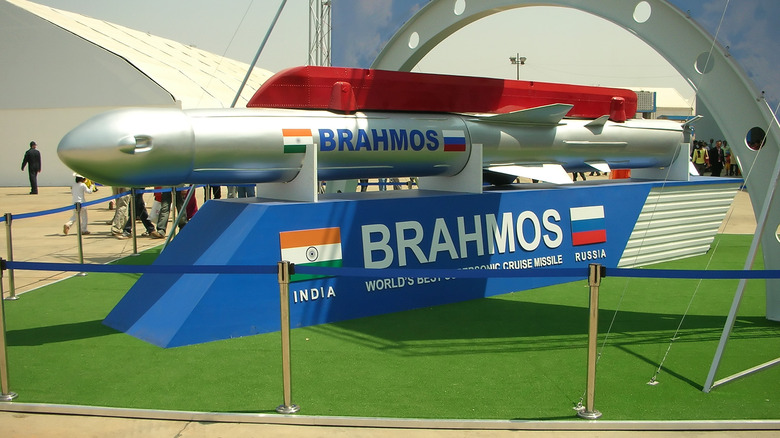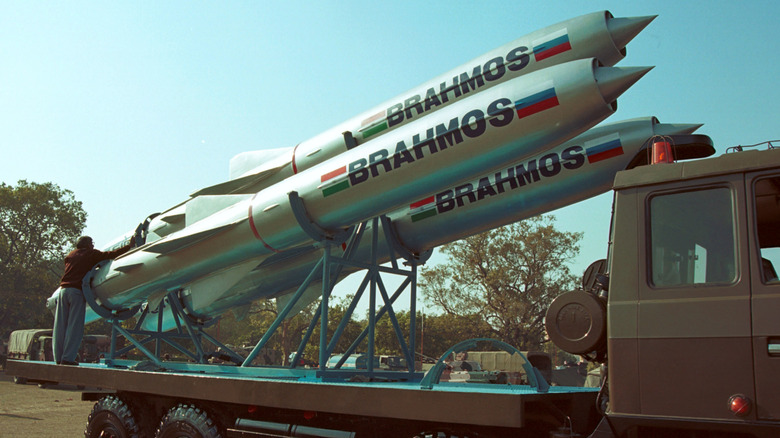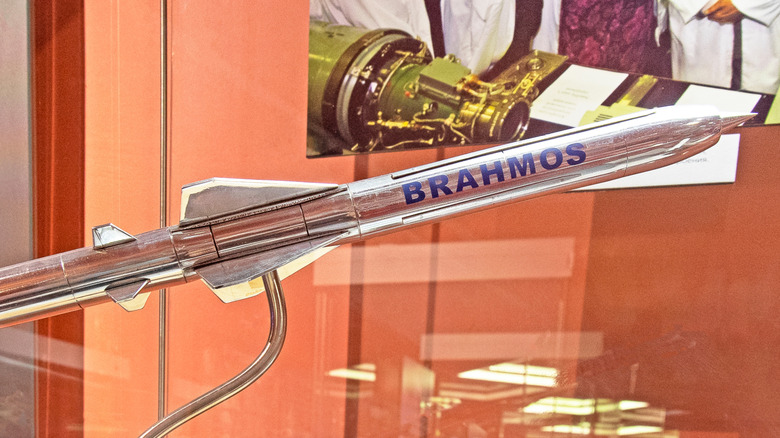What Makes India And Russia's BrahMos Missile So Deadly?
Humanity has a long history of developing ever more formidable weapons. Centuries ago, bows and slings were our deadliest weapons for unleashing damage at a distance. Today, we've advanced through a whole line of firearms, drones, and missiles; each of which can be optimized for deadliness in a range of different ways. Innovations in physics, chemistry, and engineering have given us weapons like the infamous Tsar Bomba, a Soviet weapon which is the biggest nuclear weapon to date. As the BrahMos missile proves, though, the overall deadliness of a weapon is about more than just the raw power it can bring to bear.
Of course, a weapon with low destructive power would be of limited practical use, as would a weapon with low range, limited speed, or poor accuracy. A weapon which hits all these vitals and excels in every one is a true superstar of a weapon. That's BrahMos in a nutshell. The first cruise missile capable of supersonic flight to see service, the BrahMos missile can hit Mach 2.8 and beyond, a formidable top speed for a cruise missile. This isn't only during one stage of the flight, either, but throughout its journey to its target.
The BrahMos design also limits its profile against radar detection, making it incredibly elusive. In terms of its power, it isn't typically loaded with a nuclear warhead, but BrahMos Aerospace boasts its creation offers "nine times more kinetic energy" than competing cruise missiles. That translates to a tremendously more powerful impact compared to a standard warhead.
Power and stealth in one seemingly unstoppable package
One of the most frightening aspects of a weapon is the element of the unknown it can deliver. Where will it strike and what damage is it capable of when it hits? There isn't really another armament quite like this, being the first supersonic cruise missile, which makes it even more unpredictable. Developed as a collaboration between Russia and India, its name is a testament to this terrifying joint effort. The Brah is derived from the Brahmaputra river, which runs through the Northeast of India, while the Mos references the mighty Moskva river in Eastern Russia.
Western armies, then, lack familiarity with this potent weapon. Dr. Sudhir Kumar Mishra, the former Director General of BrahMos Aerospace, has underscored this quality of the weapon. In May 2025, News 18 quoted Dr. Mishra as stating, "India and Russia only have a liquid Supersonic Cruise Missile. Even the U.S. doesn't have this. It's completely indigenous." When it comes to potentially countering the BrahMos missile, the outlook seems bleak. Dr. Mishra noted that "it cannot be intercepted by any known Defense system in the world."
It's incredibly accurate, to boot. Potential targets would find themselves extremely vulnerable. Some members of the BrahMos missile family have a range of more than 800 kilometers. And that's before considering the sheer versatility of the missile or the fact that a further improved BrahMos-II is set to be completed in the future.
A threat from land, sea, and air with BrahMos-II on the way
Some of the most potent weapons around still have operational limitations. Some are built for a specific purpose and are thus specialized for specific types of engagements, for instance. The BrahMos missile, seemingly uninterested in having any such shortcomings, can be used in a variety of ways. The first launch of a BrahMos missile in June 2001 took place on land, but it has since been adapted for deployment from both air and sea. In May 2025, the Indian Air Force used the missiles as part of Operation Sindoor, an attack on Pakistani air assets. Of course, India's army and navy also has access to them.
Dr. Mishra reported to CNBC that "enemy ships can see the BrahMos only 2 to 3 kilometers away, and it gives them about 12 to 15 seconds to react." Yet it seems there's still much more to come from the missile family yet. According to a BrahMos Aerospace press release from August 2009, BrahMos-II will be a hypersonic powerhouse capable of Mach 6 powered by a scramjet (a different concept to a ramjet).
Hypersonic testing continues, but it's a slow process. In February 2023, India Today quoted BrahMos Aerospace as stating, "If we want a hypersonic missile, we will take only eight years to develop it after approval from the government." It may be some time before it arrives, but the next version is sure to be a truly formidable weapon. Hypersonic missiles have the potential to change warfare forever, and this weapon appears slated to play a part of development.


